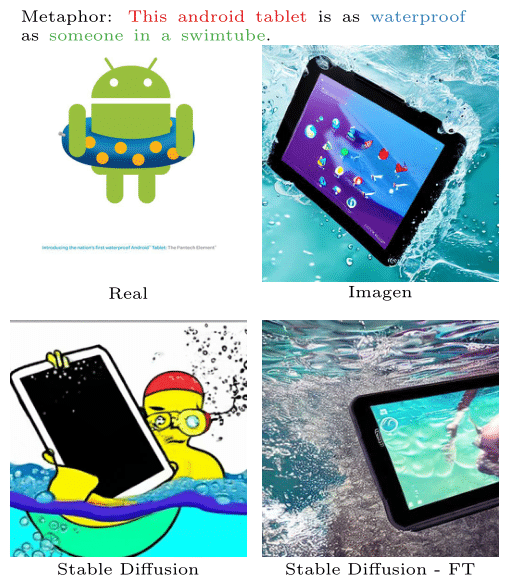MetaCLUE: Towards Comprehensive Visual Metaphors Research


Creativity is an indispensable part of human cognition and also an inherent part of how we make sense of the world. Metaphorical abstraction is fundamental in communicating creative ideas through nuanced relationships between abstract concepts such as feelings. While computer vision benchmarks and approaches predominantly focus on understanding and generating literal interpretations of images, metaphorical comprehension of images remains relatively unexplored. Towards this goal, we introduce MetaCLUE, a set of vision tasks on visual metaphor. We also collect high-quality and rich metaphor annotations (abstract objects, concepts, relationships along with their corresponding object boxes) as there do not exist any datasets that facilitate the evaluation of these tasks. We perform a comprehensive analysis of state-of-the-art models in vision and language based on our annotations, highlighting strengths and weaknesses of current approaches in visual metaphor Classification, Localization, Understanding (retrieval, question answering, captioning) and gEneration (text-to-image synthesis) tasks. We hope this work provides a concrete step towards developing AI systems with human-like creative capabilities.
Humans engage metaphors in their creative thinking process as strategies to link or blend concepts, or to view a concept from a target domain in terms of another, apparently dissimilar concept from a source domain [lakoff et al., 2008]. Take as an example 'This car is a cheetah', where This car is compared to 'a cheetah' in terms of speed. Metaphors have a simple syntactic structure of 'A is B' where A is referred to as the primary concept and B as the secondary concept. The implied analogy in a metaphor is of the form: (primary concept) is as (relationship) as (secondary concept) and often involves an attribute transfer from the secondary to the primary concept. There are at least 4 different types of visual metaphors: Contextual, Hybrid, Juxtaposition, and Multimodal.

Much of the computer vision focus on literal interpretation of images. We introduce, MetaCLUE, consisting of four interesting tasks (Classification, Understanding, Localization and Generation) related to metaphorical interpretation and generation of images. As metaphors are more common in visual Ads, we start with the Ads images and then perform a rigorous multi-stage annotation process with expert annotators to filter metaphorical images, add metaphor annotations, and perform additional validation steps to clean the annotations.
Using our collected annotations, we show that state-of-the-art vision models struggle to produce satisfactory results in many cases, demonstrating the difficulty of MetaCLUE tasks. Below are some examples:


@inproceedings{akula2023metaclue,
title={Metaclue: Towards comprehensive visual metaphors research},
author={Akula, Arjun R and Driscoll, Brendan and Narayana, Pradyumna and Changpinyo, Soravit and Jia, Zhiwei and Damle, Suyash and Pruthi, Garima and Basu, Sugato and Guibas, Leonidas and Freeman, William T and others},
booktitle={Proceedings of the IEEE/CVF Conference on Computer Vision and Pattern Recognition},
pages={23201--23211},
year={2023}
}